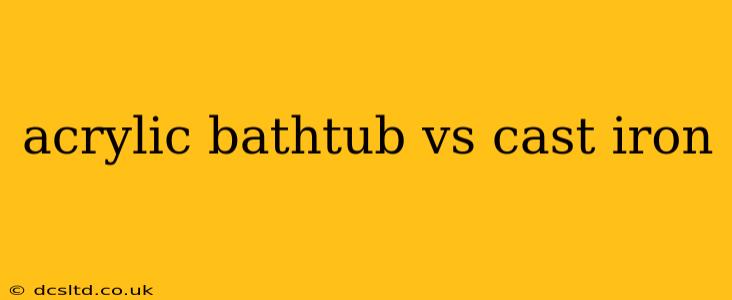Choosing a new bathtub is a significant decision, impacting both the aesthetics and functionality of your bathroom for years to come. Two popular choices often top the list: acrylic and cast iron tubs. Each material boasts unique advantages and disadvantages, making the selection process crucial. This comprehensive guide will delve into the key differences between acrylic and cast iron bathtubs, helping you make an informed decision that perfectly suits your needs and preferences.
What are the pros and cons of acrylic bathtubs?
Acrylic bathtubs have gained immense popularity due to their versatility and affordability. They are lightweight, making installation easier, and come in a wide array of shapes, sizes, and colors. However, they are not as durable as cast iron and can be prone to scratching and staining if not properly cared for.
Pros:
- Lightweight and Easy to Install: Their lighter weight simplifies installation, reducing labor costs and making them a good option for renovations.
- Affordable: Generally, acrylic tubs are more budget-friendly than cast iron alternatives.
- Variety of Styles and Colors: Acrylic offers a wide range of design options to match any bathroom décor.
- Warm to the Touch: Acrylic retains heat better than some other materials, providing a more comfortable bathing experience.
- Easy to Clean: With proper cleaning, acrylic tubs maintain their shine and cleanliness.
Cons:
- Less Durable: Compared to cast iron, acrylic is more susceptible to scratches, chips, and stains.
- Can Be Less Stable: Their lightweight nature can sometimes lead to less stability, especially in larger sizes.
- Potential for Staining: Certain substances, such as harsh chemicals or dyes, can permanently stain acrylic.
- Repair Challenges: Repairing damage to an acrylic tub can be complex and may require professional assistance.
What are the pros and cons of cast iron bathtubs?
Cast iron bathtubs, often coated with porcelain enamel, are known for their exceptional durability and longevity. They are heavy, requiring more effort for installation, and traditionally come in more classic designs. However, their robust construction and resistance to damage make them a worthwhile investment for many homeowners.
Pros:
- Extremely Durable: Cast iron tubs are built to last, resisting scratches, chips, and stains significantly better than acrylic.
- Retains Heat Well: The dense material retains water temperature exceptionally well, providing a longer, warmer bath.
- Stable and Strong: Their weight provides excellent stability, minimizing any risk of flexing or movement.
- Classic and Elegant: Cast iron tubs often exude a sense of timeless elegance, enhancing the overall bathroom aesthetic.
- Easy to Clean: The porcelain enamel surface is relatively easy to clean and maintain.
Cons:
- Heavy and Difficult to Install: The substantial weight makes installation more challenging and potentially more expensive.
- Expensive: Cast iron tubs are generally more expensive than acrylic tubs.
- Limited Design Options: Traditional cast iron tubs offer fewer design variations compared to acrylic.
- Can Chip or Crack: While durable, cast iron can still chip or crack under significant impact.
- Prone to Rust (if not enameled properly): The cast iron itself is susceptible to rust, hence the importance of a high-quality enamel coating.
Which bathtub is better for resale value?
The impact of bathtub material on resale value is subtle but noticeable. A well-maintained cast iron tub, with its reputation for durability and longevity, often adds more value to a home than an acrylic tub. However, the overall condition and style of the tub are equally significant factors. A damaged cast iron tub will obviously detract from value, while a modern, stylish acrylic tub can be just as appealing to buyers.
Which bathtub is better for a small bathroom?
For smaller bathrooms, the lightweight and space-saving nature of acrylic bathtubs is a considerable advantage. Their smaller sizes and varied designs are more easily accommodated in compact spaces. Cast iron tubs, due to their size and weight, may be less suitable for small bathrooms, potentially making the space feel cramped.
How long do acrylic and cast iron bathtubs last?
With proper care and maintenance, both acrylic and cast iron bathtubs can last for many years. Cast iron tubs are renowned for their longevity, often lasting for decades or even a century with minimal issues. Acrylic tubs typically have a lifespan of 10-15 years, although this can vary depending on usage and maintenance.
Which bathtub is easier to clean?
Both acrylic and cast iron tubs are relatively easy to clean. The smooth, non-porous surfaces of both materials prevent the build-up of grime. Regular cleaning with mild soap and water is usually sufficient to maintain cleanliness.
In conclusion, the best bathtub for you depends on your individual needs, budget, and preferences. Acrylic bathtubs offer affordability, variety, and ease of installation, while cast iron bathtubs provide exceptional durability and longevity. Carefully consider the pros and cons of each material before making your final decision.
